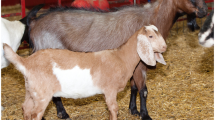Abstract
To induce constitutive immunity against a pathogenic strain ofEscherichia coli (K99), a rearranged immunoglobulin (Ig) heavy chain (HC) gene was constructed. Because the route ofE. coli infection is enteric, an IgA transgene was desirable. A chimaeric gene construct was cloned that coded for a HC that recognized a specificE. coli pilus antigen. The construct comprised a κ gene promoter, murine VDJ, and bovine α-HC constant region. Following microinjection of the HC construct into murine zygotes, of 50 liveborn mice, three were identified as transgenic. In all three transgenic founders, transgene-encoded mRNA expression was detected by northern blot. The transgenic founders were analysed for transgene-encoded RNA expression in splenic tissue before and after challenge with pathogenicE. coli. Founder 4-3♂ expressed transgene-encoded RNA both before and after challenge; expression was detected in the other two founders only post-challenge. As no differences were found when sera were analysed for bovine IgA in control and transgenic mice, protein expression was assessed by challenge of HC founders with K99E. coli by gavage. Control mice challenged with K99E. coli were moribund within 24 h post-gavage, but there was no observable affect in the three transgenic founders. Unfortunately, after obtaining offspring from all founders, no transgenic offspring were identified (0/108). The low yield of transgenic founders, coupled with the apparent germ-line mosaicism may point to either mechanical or critical developmental anomalies. However, the production of transgenic mice harbouring an Ig HC gene construct confirmed that an Ig transgene coding for an antibody to an animal pathogen could function in a tissue-specific and protective manner in a mammalian system.
Similar content being viewed by others
References
Archibald, J. (1973)The Merck Veterinary Manual. Rahway, NJ: Merck & Co., Inc. Press.
Brinster, R.L., Ritchie, K.A., Hammer, R.E., O'Brien, R.L., Arp, B. and Storb, U. (1983) Expression of a microinjected immunoglobulin gene in the spleen of transgenic mice.Nature 306, 332–6.
Brinster, R.L., Chen, H.Y., Trumbauer, M.E., Yagle, M.K. and Palmiter, R.D. (1985) Factors affecting the efficiency of introducing foreign DNA into mice by microinjecting eggs.Proc. Natl Acad. Sci. USA 82, 4438–42.
Childers, N.K., Bruce, M.G. and McGhee, J.R. (1989) Molecular mechanisms of immunoglobulin A defense.Ann. Rev. Microbiol. 43, 503–36.
Chomczynski, P. and Sacchi, N. (1987) Single-step method of RNA isolation by acid guanidinium thiocyanate-phenolchloroform extraction.Anal. Biochem. 162, 156–9.
Dean, A.G., Ching, Y.C., Williams, R.G. and Harden, L.B. (1972) Test forEscherichia coli enterotoxin using infant mice: application in a study of diarrhea in children in Honolulu.J. Infect. Dis. 124, 407–11.
Fairbrother, J.M., Harel, J. and Lariviere, S. (1990) Update on the pathogenesis and diagnosis ofE. coli disease.Proceedings of the Minnesota Swine Conference. St. Paul: University of Minnesota, pp. 311–9.
Hogan, B., Costantini, F. and Lacy, E. (1986)Manipulating the Mouse Embryo. Cold Spring Harbor, New York: Cold Spring Harbor Laboratory Press.
Inoue, T. and Nakano, K. (1984) Concentrations of the secretory immunoglobulin A in intestines of piglets.Jpn J. Vet. Sci. 46, 881–3.
Knight, K.L., Suter, M. and Becker, R.S. (1988) Genetic engineering of bovine Ig: construction and characterization of hapten-binding bovine/murine chimaeric IgE, IgA, IgG1, IgG2 and IgG3 molecules.J. Immunol. 140, 3654–9.
Kohler, E.M. (1972) Pathogenesis of neonatal enteric colibacillosis of pigs.J. Am. Vet. Med. Assn. 160, 574–82.
Lo, D., Pursel, V., Linton, P.J., Sandgren, E., Behringer, R., Rexroad, C., Palmiter, R.D. and Brinster, R.L. (1991) Expression of mouse IgA by transgenic mice, pigs and sheep.Eur. J. Immunol. 21, 1001–6.
Palmiter, R.D. and Brinster, R.L. (1986) Germ-line transformation of mice.Ann. Rev. Genet. 20, 465–99.
Pinkert, C.A. (1987) Gene transfer and the production of transgenic livestock.Proc. US Anim. Health Assn 91, 129–41.
Pinkert, C.A., Manz, J., Linton, P.J., Klinman, N.R. and Storb, U. (1989) Elevated PC responsive B cells and anti-PC antibody production in transgenic mice harboring anti-PC immunoglobulin genes.Vet. Immunol. Immunopath. 23, 321–3.
Polites, H.G. and Pinkert, C.A. (1994) Transgenic animal production using DNA microinjection. In Pinkert, C.A. ed.,Transgenic Animal Technology: a Laboratory Handbook, pp. 15–68. New York: Academic Press.
Sambrook, J., Fritsch, E.F. and Maniatis, T. (1989)Molecular Cloning: a Laboratory Manual. Cold Spring Harbor, New York: Cold Spring Harbor Laboratory Press.
Schmidt, C.B. (1985) Persistant scours problems may require farmspecific answers.Natl. Hog Farmer, pp. 26–9.
Sherman, D.M., Acres, S.D., Sadowski, P.L., Springer, J.A., Bray, B., Raybould, T.J.G. and Muscoplat, C.C. (1983) Protection of calves against fatal enteric colibacillosis by orally administeredEscherichia coli K99-specific monoclonal antibody.Infection Immunity 42, 653–8.
Storb, U., Pinkert, C., Arp, B., Engler, P., Gollahon, K., Manz, J., Brady, W. and Brinster, R. (1986) Transgenic mice with μ and κ genes encoding antiphosphorylcholine antibodies.J. Exp. Med. 164, 627–41.
Tizard, I. (1987)Veterinary Immunology: an Introduction. Philadelphia: W.B. Saunders & Company.
Underdown, B.J. and Schiff, J.M. (1986) Immunoglobulin A: strategic defense initiative at the mucosal surface.Ann. Rev. Immunol. 4, 389–417.
Vaillancourt, J.P., Marsh, W.E. and Dial, G.D. (1990) Causes and risk factors associated with preweaning mortality under endemic conditions.Proceedings of the Minnesota Swine Conference, pp. 136–57. St. Paul: University of Minnesota.
Weidle, U.H., Lenz, H. and Brem, G. (1991) Genes encoding a mouse monoclonal antibody are expressed in transgenic mice, rabbits and pigs.Gene 98, 185–91.
Whitelaw, C.B.A., Springbett, A.J., Webster, J. and Clark, J. (1993) The majority of G0 transgenic mice are derived from mosaic embryos.Transgen. Res. 2, 29–32.
Author information
Authors and Affiliations
Rights and permissions
About this article
Cite this article
Kooyman, D.L., Pinkert, C.A. Transgenic mice expressing a chimaeric anti-E. coli immunoglobulin α heavy chain gene. Transgenic Research 3, 167–175 (1994). https://doi.org/10.1007/BF01973984
Received:
Revised:
Accepted:
Issue Date:
DOI: https://doi.org/10.1007/BF01973984




